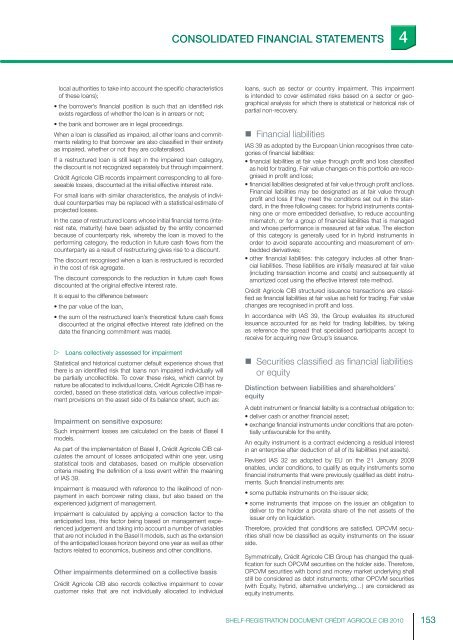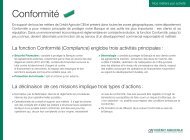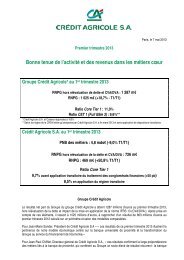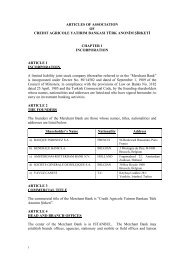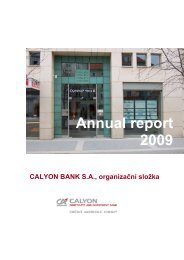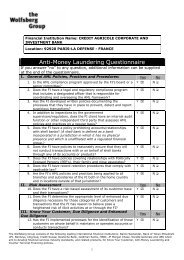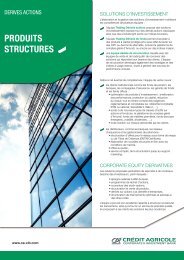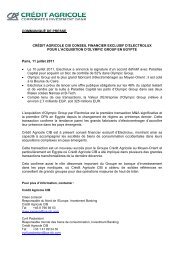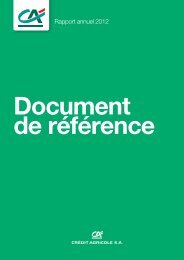ourexpertise - Crédit Agricole CIB
ourexpertise - Crédit Agricole CIB
ourexpertise - Crédit Agricole CIB
You also want an ePaper? Increase the reach of your titles
YUMPU automatically turns print PDFs into web optimized ePapers that Google loves.
CONSOLIDATED FINANCIAL STATEMENTS 4local authorities to take into account the specifi c characteristicsof these loans);• the borrower’s fi nancial position is such that an identifi ed riskexists regardless of whether the loan is in arrears or not;• the bank and borrower are in legal proceedings.When a loan is classifi ed as impaired, all other loans and commitmentsrelating to that borrower are also classifi ed in their entiretyas impaired, whether or not they are collateralised.If a restructured loan is still kept in the impaired loan category,the discount is not recognized separately but through impairment.<strong>Crédit</strong> <strong>Agricole</strong> <strong>CIB</strong> records impairment corresponding to all foreseeablelosses, discounted at the initial effective interest rate.For small loans with similar characteristics, the analysis of individualcounterparties may be replaced with a statistical estimate ofprojected losses.In the case of restructured loans whose initial fi nancial terms (interestrate, maturity) have been adjusted by the entity concernedbecause of counterparty risk, whereby the loan is moved to theperforming category, the reduction in future cash fl ows from thecounterparty as a result of restructuring gives rise to a discount.The discount recognised when a loan is restructured is recordedin the cost of risk agregate.The discount corresponds to the reduction in future cash fl owsdiscounted at the original effective interest rate.It is equal to the difference between:• the par value of the loan,• the sum of the restructured loan’s theoretical future cash fl owsdiscounted at the original effective interest rate (defi ned on thedate the fi nancing commitment was made).Loans collectively assessed for impairmentStatistical and historical customer default experience shows thatthere is an identifi ed risk that loans non impaired individually willbe partially uncollectible. To cover these risks, which cannot bynature be allocated to individual loans, <strong>Crédit</strong> <strong>Agricole</strong> <strong>CIB</strong> has recorded,based on these statistical data, various collective impairmentprovisions on the asset side of its balance sheet, such as:Impairment on sensitive exposure:Such impairment losses are calculated on the basis of Basel IImodels.As part of the implementation of Basel II, <strong>Crédit</strong> <strong>Agricole</strong> <strong>CIB</strong> calculatesthe amount of losses anticipated within one year, usingstatistical tools and databases, based on multiple observationcriteria meeting the defi nition of a loss event within the meaningof IAS 39.Impairment is measured with reference to the likelihood of nonpaymentin each borrower rating class, but also based on theexperienced judgment of management.Impairment is calculated by applying a correction factor to theanticipated loss, this factor being based on management experiencedjudgement and taking into account a number of variablesthat are not included in the Basel II models, such as the extensionof the anticipated losses horizon beyond one year as well as otherfactors related to economics, business and other conditions.Other impairments determined on a collective basis<strong>Crédit</strong> <strong>Agricole</strong> <strong>CIB</strong> also records collective impairment to covercustomer risks that are not individually allocated to individualloans, such as sector or country impairment. This impairmentis intended to cover estimated risks based on a sector or geographicalanalysis for which there is statistical or historical risk ofpartial non-recovery.• Financial liabilitiesIAS 39 as adopted by the European Union recognises three categoriesof fi nancial liabilities:• fi nancial liabilities at fair value through profi t and loss classifi edas held for trading. Fair value changes on this portfolio are recognisedin profi t and loss;• fi nancial liabilities designated at fair value through profi t and loss.Financial liabilities may be designated as at fair value throughprofi t and loss if they meet the conditions set out in the standard,in the three following cases: for hybrid instruments containingone or more embedded derivative, to reduce accountingmismatch, or for a group of fi nancial liabilities that is managedand whose performance is measured at fair value. The electionof this category is generally used for in hybrid instruments inorder to avoid separate accounting and measurement of embeddedderivatives;• other fi nancial liabilities: this category includes all other fi nancialliabilities. These liabilities are initially measured at fair value(including transaction income and costs) and subsequently atamortized cost using the effective interest rate method.<strong>Crédit</strong> <strong>Agricole</strong> <strong>CIB</strong> structured issuance transactions are classified as fi nancial liabilities at fair value as held for trading. Fair valuechanges are recognised in profi t and loss.In accordance with IAS 39, the Group evaluates its structuredissuance accounted for as held for trading liabilities, by takingas reference the spread that specialised participants accept toreceive for acquiring new Group’s issuance.• Securities classifi ed as fi nancial liabilitiesor equityDistinction between liabilities and shareholders’equityA debt instrument or fi nancial liability is a contractual obligation to:• deliver cash or another fi nancial asset;• exchange fi nancial instruments under conditions that are potentiallyunfavourable for the entity.An equity instrument is a contract evidencing a residual interestin an enterprise after deduction of all of its liabilities (net assets).Revised IAS 32 as adopted by EU on the 21 January 2009enables, under conditions, to qualify as equity instruments somefi nancial instruments that were previously qualifi ed as debt instruments.Such fi nancial instruments are:• some puttable instruments on the issuer side;• some instruments that impose on the issuer an obligation todeliver to the holder a prorata share of the net assets of theissuer only on liquidation.Therefore, provided that conditions are satisfi ed, OPCVM securitiesshall now be classifi ed as equity instruments on the issuerside.Symmetrically, <strong>Crédit</strong> <strong>Agricole</strong> <strong>CIB</strong> Group has changed the qualification for such OPCVM securities on the holder side. Therefore,OPCVM securities with bond and money market underlying shallstill be considered as debt instruments; other OPCVM securities(with Equity, hybrid, alternative underlying…) are considered asequity instruments.SHELF-REGISTRATION DOCUMENT CRÉDIT AGRICOLE <strong>CIB</strong> 2010 153


